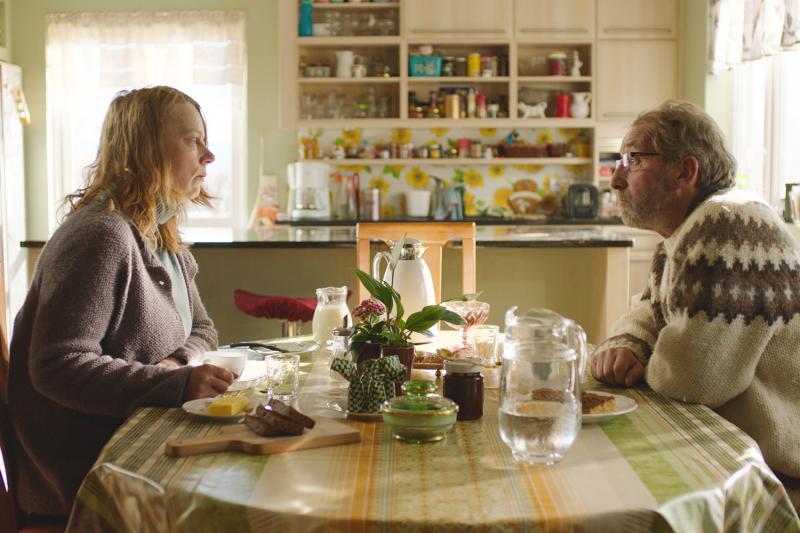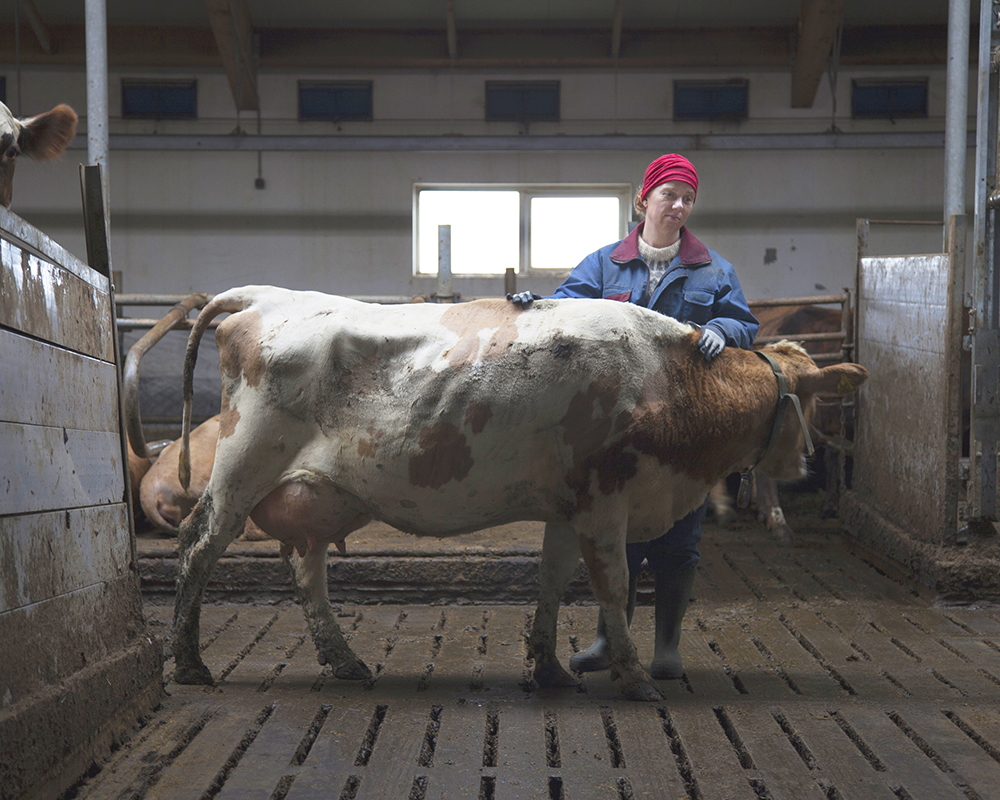The County review - Icelandic drama from the director of 'Rams' | reviews, news & interviews
The County review - Icelandic drama from the director of 'Rams'
The County review - Icelandic drama from the director of 'Rams'
Grímur Hákonarson’s latest feature cuts to the quick of local politics

Like Rams before it, the ice-glazed hillsides and stark ochre grasslands of northern Iceland are the backdrop for Grímur Hákonarson’s third feature The County, a rural drama that explores the murkier side of local politics.
Inga (Arndís Hrönn Egilsdóttir) is a middle-aged, tough-as-nails dairy farmer. She’s grieving for her late husband who recently committed suicide, jack-knifing his truck into a ravine. We later discover he ended his life because of punishing debts owed to a corrupt cooperative that dominates the local farming community. This leaves Igna running the farm near Dalsmynni alone. The discovery that her husband was being threatened ignites her anger and she decides to tackle the co-op head on, with a pit bull-like determination reminiscent of Frances McDormand in Three Billboards.  It’s a rousing, naturalistic drama that portrays the tough realities of rural life, anchored in an excellent central performance from Egilsdóttir. Hákonarson immerses us in the daily toil of running a farm, as Inga stoically goes about her business. She finds a way to run the operation almost single-handed, having forked out the cash to automate the milking and mucking out.
It’s a rousing, naturalistic drama that portrays the tough realities of rural life, anchored in an excellent central performance from Egilsdóttir. Hákonarson immerses us in the daily toil of running a farm, as Inga stoically goes about her business. She finds a way to run the operation almost single-handed, having forked out the cash to automate the milking and mucking out.
Sigurður Sigurjónsson makes a wonderfully villainous antagonist as Eyjólfur, the don of the mafia-like organisation, skulking around the county, twisting arms, whispering lies, and grinning like a Cheshire Cat as he goes about his wicked business.
Arguments are made for and against such co-operatives. This is after all a punishing environment, geographically and financially, following the 2008 crash. Hákonarson shows us that it’s only through cooperation that communities survive, but it also opens the door to corruption.
There are moments that are borderline cliché, but the drama is never broad. Hákonarson keeps a tight hold on this simple yet effective drama. It’s impossible not to feel Inga’s anger and hurt and, whilst slight, there’s a good deal of pleasure to be taken from this underdog tale.
rating
Share this article
The future of Arts Journalism
You can stop theartsdesk.com closing!
We urgently need financing to survive. Our fundraising drive has thus far raised £49,000 but we need to reach £100,000 or we will be forced to close. Please contribute here: https://gofund.me/c3f6033d
And if you can forward this information to anyone who might assist, we’d be grateful.

Subscribe to theartsdesk.com
Thank you for continuing to read our work on theartsdesk.com. For unlimited access to every article in its entirety, including our archive of more than 15,000 pieces, we're asking for £5 per month or £40 per year. We feel it's a very good deal, and hope you do too.
To take a subscription now simply click here.
And if you're looking for that extra gift for a friend or family member, why not treat them to a theartsdesk.com gift subscription?
more Film
 Bugonia review - Yorgos Lanthimos on aliens, bees and conspiracy theories
Emma Stone and Jesse Plemons excel in a marvellously deranged black comedy
Bugonia review - Yorgos Lanthimos on aliens, bees and conspiracy theories
Emma Stone and Jesse Plemons excel in a marvellously deranged black comedy
 theartsdesk Q&A: director Kelly Reichardt on 'The Mastermind' and reliving the 1970s
The independent filmmaker discusses her intimate heist movie
theartsdesk Q&A: director Kelly Reichardt on 'The Mastermind' and reliving the 1970s
The independent filmmaker discusses her intimate heist movie
 Blu-ray: Wendy and Lucy
Down-and-out in rural Oregon: Kelly Reichardt's third feature packs a huge punch
Blu-ray: Wendy and Lucy
Down-and-out in rural Oregon: Kelly Reichardt's third feature packs a huge punch
 The Mastermind review - another slim but nourishing slice of Americana from Kelly Reichardt
Josh O'Connor is perfect casting as a cocky middle-class American adrift in the 1970s
The Mastermind review - another slim but nourishing slice of Americana from Kelly Reichardt
Josh O'Connor is perfect casting as a cocky middle-class American adrift in the 1970s
 Springsteen: Deliver Me From Nowhere review - the story of the Boss who isn't boss of his own head
A brooding trip on the Bruce Springsteen highway of hard knocks
Springsteen: Deliver Me From Nowhere review - the story of the Boss who isn't boss of his own head
A brooding trip on the Bruce Springsteen highway of hard knocks
 The Perfect Neighbor, Netflix review - Florida found-footage documentary is a harrowing watch
Sundance winner chronicles a death that should have been prevented
The Perfect Neighbor, Netflix review - Florida found-footage documentary is a harrowing watch
Sundance winner chronicles a death that should have been prevented
 Blu-ray: Le Quai des Brumes
Love twinkles in the gloom of Marcel Carné’s fogbound French poetic realist classic
Blu-ray: Le Quai des Brumes
Love twinkles in the gloom of Marcel Carné’s fogbound French poetic realist classic
 Frankenstein review - the Prometheus of the charnel house
Guillermo del Toro is fitfully inspired, but often lost in long-held ambitions
Frankenstein review - the Prometheus of the charnel house
Guillermo del Toro is fitfully inspired, but often lost in long-held ambitions
 London Film Festival 2025 - a Korean masterclass in black comedy and a Camus classic effectively realised
New films from Park Chan-wook, Gianfranco Rosi, François Ozon, Ildikó Enyedi and more
London Film Festival 2025 - a Korean masterclass in black comedy and a Camus classic effectively realised
New films from Park Chan-wook, Gianfranco Rosi, François Ozon, Ildikó Enyedi and more
 After the Hunt review - muddled #MeToo provocation
Julia Roberts excels despite misfiring drama
After the Hunt review - muddled #MeToo provocation
Julia Roberts excels despite misfiring drama
 London Film Festival 2025 - Bradley Cooper channels John Bishop, the Boss goes to Nebraska, and a French pandemic
... not to mention Kristen Stewart's directing debut and a punchy prison drama
London Film Festival 2025 - Bradley Cooper channels John Bishop, the Boss goes to Nebraska, and a French pandemic
... not to mention Kristen Stewart's directing debut and a punchy prison drama
 Ballad of a Small Player review - Colin Farrell's all in as a gambler down on his luck
Conclave director Edward Berger swaps the Vatican for Asia's sin city
Ballad of a Small Player review - Colin Farrell's all in as a gambler down on his luck
Conclave director Edward Berger swaps the Vatican for Asia's sin city

Add comment